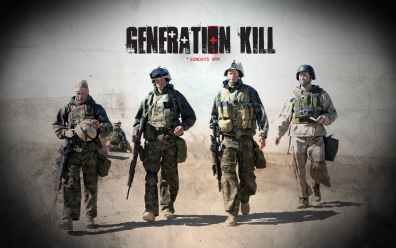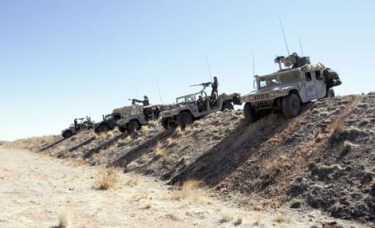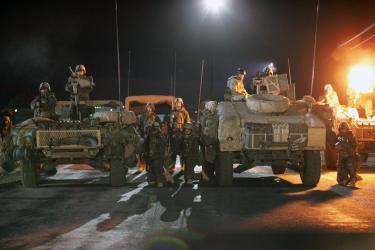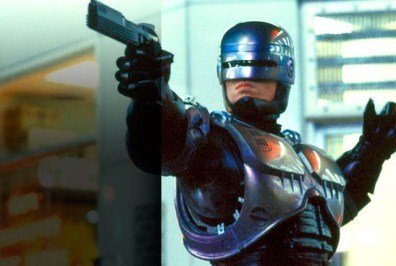Matthew S. Williams's Blog, page 196
July 18, 2012
Anthology Sample: “Swan Song”
 Hello all. There’s plenty of things happening on the Anthology front! More authors, more contributions, and more final drafts being produced. As it happens, our good contributor and friend here, Melanie Edmonds, has just finished work on her story “Swan Song”. This is the third installment in Part II of the anthology, which deals with the final mission of the Colony Ships.
Hello all. There’s plenty of things happening on the Anthology front! More authors, more contributions, and more final drafts being produced. As it happens, our good contributor and friend here, Melanie Edmonds, has just finished work on her story “Swan Song”. This is the third installment in Part II of the anthology, which deals with the final mission of the Colony Ships.
The story takes place roughly 100 years after Planetfall is made, when the Avincenna, Taftazani, and Kashani delivered the first wave of colonists to Yuva. Those who crewed them have lived a comparatively empty existence ever since, being unable to live planetside due to the intense gravity and finding little else of value to do since.
Edmonds take us into the world of these people and inside the ships as they perform their final duty to the colony and embrace their destiny. Here is the first section of the story, fresh from the digital press!
They say there is a swan that is silent for its whole life. It grows and loves and does all the swan-like things, but it does not utter a sound. Then, the moment before it dies, it opens its throat, and not even the vacuum of space can swallow the beauty of its song.
* * * *
[The image broadcast across the Yuva networks is dominated by the great globe of her sun, Gliese 581. Nearing the glow, three shapes track slowly and majestically. Their silhouettes are familiar, for they are the great colony ships.]
[Transmission Voiceover]
“It has been ten years since we arrived here. Ten years since we slowed our ships and woke our children. Ten years since we put a stake in this planet and said, ‘this is our new home’. This is Yuva.”
* * * *
Avicenna, Bridge
Gliese 581 – 20 minutes
“Final corrections made. We’re on approach vector.” Pilot Gnana Tanaq slid her hands off the controls. This is the last time I’ll do this, she thought. “Inertia will carry us in, now.”
The first time she touched the console, her hands were smooth and soft, barely out of puberty. Now, sixty-four years later, they were wrinkled and worn, though they still curled around the grips easily. Just as she had worn shiny spots into the plastic, so the grips had worn her hands into control-friendly curves. Pilots’ claws, some people called them. She bore hers proudly.
Behind her, she felt Jackson sigh and loosen his grip on his console. “So, that’s it, then.”
“Yup.”
“How long?”
Gnana glanced down at the readouts scrolling before her. “Not long. Twenty minutes, maybe, depending on how quickly the gravity pulls us in.” She turned her chair so she could see him. “You’re the navigator, though.”
Jackson didn’t even bother to check his readings. He shrugged. “Sounds right.”
She smiled at him, dark skin crinkling around her eyes. “I know, I know: it goes against everything you believe in to navigate purposefully into something.”
He wrinkled his nose and his moustache twitched. “I keep wanting to tell you to alter course. Can’t help it.”
Gnana laughed softly, but there was no real humour in it. The forward viewports were unshuttered and Gliese 581 filled the entire window. Its orange glow lit the Bridge as if it was already on fire.
With a sigh, she unclipped the tether that held her to the chair and pushed over to where Jackson floated. She covered his hand with hers and his head dipped slightly in acknowledgement. The sunlight was turning his hair red, like it had been years ago. Gnana used to joke that he was the whitest man she’d ever met, so pale he wasn’t even freckled. Like her, he’d spent his whole life in space behind radiation shielding; his skin had never felt the real touch of a sun. Another twenty minutes would change that.
She turned her attention forward. It was hard to look at the Bridge now; it wasn’t the home she had known anymore. She had expected memories to crowd in here, but instead, all she saw was gaps. The holes where missing stations once were: communications, cryonics, long-range sensors. The stripped-down environmental console and the bare patches of decking where chairs used to be; the only one remaining was hers, because the pilot still needed it for this final journey. Even navigation was stripped down.
This room used to be busy with bodies, full of shifting console displays and the shadows of the crew. Now, it was just her and Jackson.
Gnana glanced sideways and saw Jackson frowning. “Still angry that he chose not to come?” She didn’t have to say who she meant; he knew.
Jackson’s expression scrunched down. “His place is here.”
“It was his choice.” Gnana’s tone was non-committal; in truth, she wasn’t sure what she thought about the captain’s decision.
Three days ago, she had agreed with Jackson: the captain was a coward who refused the honourable path. They had all known this was a likely end to this journey when they signed on, but he had chosen to stay on the orbital platforms, training the colonists in… she wasn’t even sure what.
Then, the night before they departed on their final voyage, she had seen the captain at a bar. It was the only time in her life she had ever seen him drunk, and it wasn’t pretty. He had slurred goodbye to her and hugged her – hugged her – and she had seen it in his eyes. It tore him up to deny his duty but he wasn’t ready to stand on his ship and sail into the sun for the last time; there was still living left for him to do.
She couldn’t begrudge him that. He was younger than the other captains, though his time commanding the Avicenna meant he would never be able to step foot on the planet below. The toll of space on bones and organs meant the gravity would kill him, slowly and painfully. But he could have a life on the orbital platforms, maybe even lead the colonial effort the way he had led the ship.
She had considered staying too, but the only position open for her was as a shuttle pilot. It wasn’t anything like flying the Avicenna, though, and even a short atmospheric stay caused her pain. The last time, she’d had a bone-deep ache for two weeks afterwards, making her hands shake so badly that she couldn’t fly at all.
Besides, she was tired. This was her last flight, and it seemed fitting to her that it was with her baby, her ship, the machine that spoke to her through her hands on its controls.
With a sigh, she lifted her gaze to the sun burning before them.
“Look on the bright side,” she said to Jackson without looking. “Maybe you’ll finally get a tan.”
And that’s from Part II of the novel, so suffice it to say, we’re making headway! Stay tuned for more!


Generation Kill
 Hey all. Today I’m stepping outside the box to cover a review in honor of a friend of mine. Master Seaman Chris Jenkins, who recently moved across the country and won’t be in our neck of the woods for the next three years. Ah, that’s going to be rough. Luckily, there’s still this thing known as the internet and the communications it allows for.
Hey all. Today I’m stepping outside the box to cover a review in honor of a friend of mine. Master Seaman Chris Jenkins, who recently moved across the country and won’t be in our neck of the woods for the next three years. Ah, that’s going to be rough. Luckily, there’s still this thing known as the internet and the communications it allows for.
And like I earlier, I still owe him this review and I hope it finds him in good spirits when he gets to the other side of the country. And since I loved this series myself, I’m willing to step outside the confines of sci-fi to honor it. It was downright awesome, and historically relevant. So here goes…
Background:
For those who don’t know, Generation Kill was an HBO miniseries adapted from the book of the same name. Said book was the result of reporter Evan Wright’s own experiences as an embedded reporter with the 1st Marine Reconnaissance Battalion during the 2003 Invasion of Iraq. In the course of his time with them, he had a first hand view of the invasion and all the problems that resulted.
And therein lies the real value of this miniseries. Whereas many people who witnessed the invasion, particularly in the US, seemed to think that the initial phase of the war was a success, that problems didn’t arise until after the occupation began, this series and the book that inspired it shows that the problems that would come to consume Iraq were there from day one. These included lawlessness, incompetence on behalf of the civilian planners, civilian deaths, insurgency, and the glaring gap between the reality of the situation on the ground and how it was being portrayed by politicians and media.
Plot Synopsis:
The story, which begins with the invasion and culminates in the arrival and settlement of 1st Recon around Baghdad, is told through seven episodes. Each one catalogs a different phase in the war effort, showing events from multiple points of view of those who fought with Bravo Company, the Company which led the way during the invasion.
Episode 1: “Get Some” The episode opens with the 1st Recon Battalion, Bravo Company, conducting training drills inside Kuwait outside of Camp Mathilda. The embedded reporter from Rolling Stone magazine, Evan Wright (Lee Tergesen), arrives at camp and is given to 2nd Platoon where he receives a frosty welcome. Considering him a member of the “left-wing liberal media” they don’t have much love for him, until they learn he used to write for Hustler magazine!
The episode opens with the 1st Recon Battalion, Bravo Company, conducting training drills inside Kuwait outside of Camp Mathilda. The embedded reporter from Rolling Stone magazine, Evan Wright (Lee Tergesen), arrives at camp and is given to 2nd Platoon where he receives a frosty welcome. Considering him a member of the “left-wing liberal media” they don’t have much love for him, until they learn he used to write for Hustler magazine!
He quickly makes the acquaintance of the men of Bravo company whom he will be riding with in the lead Humvee. This includes Sgt. Brad “Iceman” Colbert (Alexander Skarsgard, Erik on True Blood), Cpl. Josh Ray Person (James Ransone), and relative FNG Lance Cpl. Harold James Trombley (Billy Lush). Throughout the first episode, we also get to meet many other “characters” of interest.
These includes Lt. Col. Stephen Ferrando (Chance Kelly), who was given the nickname ‘Godfather’ because throat surgery has left him with a harsh, whispery voice. Then there’s Lt. Nathaniel Fick (Stark Sands), the levelheaded commander of 2nd Platoon; Cpt. Craig ‘Encino Man’ Schwetje (Brian Patrick Wade), the well-meaning but incompetent commander of Bravo Company; Dave ‘Captain America’ McGraw (Eric Nenninger), the edgy and unstable commander of 3rd platoon; and Sgt. Rodolfo ‘Rudy’ Reyes, aka. “Fruity-Rudy” (played by himself), the openly gay Marine who acts as the glue of Bravo Company.
Significance: This episode familiarizes the viewer with several realities that Marines in the 1st Recon had to deal with. The first and most obvious is shortages, which the Marines are constantly told to make do with. The second is the fact that much of Bravo Company’s own officers are inept, enforcing pointless rules instead of focusing on troop morale or making sure they have the right kinds of equipment.
Episode 2: “The Cradle of Civilization” The invasion is now underway and 1st Recon is sent to An Nasiriyah where the invasion has stalled. Bravo Company begins to lead the way through the town and is given orders to fire on anyone they deem a threat. They encounter minimal gunfire until Cpt. McGraw, using a captured AK, opens fire on civilian cars for no apparent reason. They continue to press forward north into Mesopotamia, “The Cradle of Civilization”.
The invasion is now underway and 1st Recon is sent to An Nasiriyah where the invasion has stalled. Bravo Company begins to lead the way through the town and is given orders to fire on anyone they deem a threat. They encounter minimal gunfire until Cpt. McGraw, using a captured AK, opens fire on civilian cars for no apparent reason. They continue to press forward north into Mesopotamia, “The Cradle of Civilization”.
After taking a wrong turn, Bravo company rushes onward to reach to its next objective outside the town of Al Gharraf by nightfall. In the dark, Bravo company comes under fire by a group of armed Iraqis and takes them down without difficulty. They score their first kills and survive their baptism by fire, and Bravo company celebrates before moving on.
Significance: This episode is the first time that 1st Recon experiences combat and the first time that Cpt. McGraw commits a stupid act in the line of duty. His confiscating of an AK and firing randomly is a constant source of irritation as time goes on, but nothing is ever done about it. In addition, this episode, specifically the layout of the town, the bridge and the operation into the town, was the inspiration for COD: Modern Warfare 2, much like how scenes from Enemy at the Gates inspired Call of Duty 1 and 2 and COD: World at War.
Episode 3: “Screwby” After surviving their first engagement, Bravo presses forward. When they reach a roadside hamlet, the company look on in disbelief as a regimental combat team arrives and obliterates the hamlet and its inhabitants, none of whom appeared to be armed. Shortly thereafter, Bravo heads north to the town of Ar Rifa, where Captain Schwetje orders a “danger close” artillery barrage on the settlement. Lt. Fick intervenes to try to prevent the unwarranted barrage, but to no avail. Once again, civilians are killed due to incompetence of senior officers.
After surviving their first engagement, Bravo presses forward. When they reach a roadside hamlet, the company look on in disbelief as a regimental combat team arrives and obliterates the hamlet and its inhabitants, none of whom appeared to be armed. Shortly thereafter, Bravo heads north to the town of Ar Rifa, where Captain Schwetje orders a “danger close” artillery barrage on the settlement. Lt. Fick intervenes to try to prevent the unwarranted barrage, but to no avail. Once again, civilians are killed due to incompetence of senior officers.
Eager once more to press ahead, “Godfather” orders 1st Recon to push ahead another 40 km and capture an airstrip being controlled by Iraqi Republican Guard unit that is apparently equipped with tanks. Once again, Cpt. MgCraw begins to undermine morale by making all kinds of panicky statements, namely that they are going to die if they go up against the tanks. Also, in order to reach the airfield, they are forced to leave behind their supply trucks behind.
Once again, Bravo Company is given permission to open fire on anything that moves. In the lead Humvee, Cpl. Tromblay opens fire on people running along the roadside and severely injures a small boy. The Company secures the airfield, which appears to be abandoned, and then insists that command medevac the boy to a nearby base. Command is hesitant, but eventually agrees, and both Sgt. Colbert and Cpl. Tromblay are to told to expect consequences for the incident.
Significance: In this episode, we get a solid glimpse of how civilian deaths in Iraq are being swept under the rug and written off as justifiable. The soldiers are beginning to feel the weight of this and cracks begin to show in their morale and resolve. After both engagements, in the hamlet and Ar Rifa, they tell each other to put it out of their minds and move on, knowing that there isn’t much they can do about it.
Episode 4: “Combat Jack” 1st Recon reaches the airfield and encounters minimal resistance, the Republican Guard unit having already evacuated and left their tanks behind. This puts 1st Recon ahead of the rest of the American invasion, which is seen as something favorable to command. However, they soon learn that by leaving their supply trucks behind, that Iraqis have captured and looted them. Amongst the supplies was most of Bravo Company’s rations and an American flag, which means they are now down to one meal a day.
1st Recon reaches the airfield and encounters minimal resistance, the Republican Guard unit having already evacuated and left their tanks behind. This puts 1st Recon ahead of the rest of the American invasion, which is seen as something favorable to command. However, they soon learn that by leaving their supply trucks behind, that Iraqis have captured and looted them. Amongst the supplies was most of Bravo Company’s rations and an American flag, which means they are now down to one meal a day.
Alpha Company is then tasked with a different mission: to recover the body of a captured Marine who was murdered in Ah Shatra. The mission takes a turn when when CIA agents show up and declare that a special army of Iraqi Freedom Fighters will take the town for the sake of their propaganda campaign. However, the army deserts the next day after an artillery barrage fails to clear the town of the enemy. Meanwhile, Bravo company continues clearing hamlets along the northern route and sets up a roadblock outside of Al Hayy. The rules of engagement here are unclear, and Bravo ends up destroying a large truck and killing all passengers, uncertain if it even posed a threat.
Significance: Three major developments happen in this episode, all of which demonstrate a considerable amount about the unfolding war. First, it becomes clear to the Marines that their officers are making all the wrong calls, but as long as they continue to be successful, command will keep making them. The operation outside of Al Hayy shows just how important propaganda efforts are to the war effort, namely maintaining the illusion that the Iraqis welcome the invasion as liberation. And last, we get a first glimpse of how the Marines will have problems acting as police in the streets, mainly because they are not trained for the role.
Episode 5: “A Burning Dog” 1st Recon finally gets some solid intel from the locals, which says that there is an ambush waiting for them up ahead. The ambush is attacked by some LAV’s, and Bravo is ordered to cross the bridge at night. However, they hit a snag along the way and the convoy gets stuck, just as a group of fresh ambushees show up to attack them. Schwetje once again shows his incompetence by being unable to resolve the situation, and Cpt. McGraw once again panics and begins screaming over the open radio. Things are only resolved when Rudy intervenes and inspires Cpt Schwetje to think outside the box.
1st Recon finally gets some solid intel from the locals, which says that there is an ambush waiting for them up ahead. The ambush is attacked by some LAV’s, and Bravo is ordered to cross the bridge at night. However, they hit a snag along the way and the convoy gets stuck, just as a group of fresh ambushees show up to attack them. Schwetje once again shows his incompetence by being unable to resolve the situation, and Cpt. McGraw once again panics and begins screaming over the open radio. Things are only resolved when Rudy intervenes and inspires Cpt Schwetje to think outside the box.
By morning, Bravo company learns that they are not soldiers, but militiamen, many of whom came from Syria and farther abroad. On passports recovered from the bodies, it says that their reason for coming to Iraq was “Jihad”. Bravo continues north to Al Muwafaqiyah, where they are tasked with setting up another roadblock and with destroying the Republican Guard outpost, which, unfortunately, is in the town’s only school. Despite Colbert’s orders to hold their fire unless its absolutely necessary, Bravo has another incident at the road block and a small child is killed.
Significance: This episode is especially significant because it shows how the roots of the insurgency began long before the war ended. Whereas Captain Schwetje thinks this is proof of what Bush said about their being terrorists in Iraq, the others see from their passports that the “Jihadis” didn’t enter Iraq until the day after the US declared war. Already, the invasion is beginning to have consequences that no one seemed to plan for, particularly in how it is involving people from outside Iraq. What’s more, the mounting civilian deaths is forcing the Marines to question the war and what their role in it really is.
Episode 6: “Stay Frosty” Outside of Al Kut, Cpt. McGraw nearly kills a prisoner with his bayonet after his Company defeats a small group of armed Iraqis. His men are becoming more disillusioned in his command, and Sgt. Eric Kocher (Owain Yeoman) of 3rd platoon learns that he is being held accountable for the incident. Afterward, McGraw’s men refuse to allow him to anywhere near prisoners, for fear that he will attempt to stab them again. In addition, 1st Recon learns that Godfather’s counterpart in the Regimental Combat Team is being relieved of command despite his success. Apparently, command is reigning people in due to problems with deaths and insubordination.
Outside of Al Kut, Cpt. McGraw nearly kills a prisoner with his bayonet after his Company defeats a small group of armed Iraqis. His men are becoming more disillusioned in his command, and Sgt. Eric Kocher (Owain Yeoman) of 3rd platoon learns that he is being held accountable for the incident. Afterward, McGraw’s men refuse to allow him to anywhere near prisoners, for fear that he will attempt to stab them again. In addition, 1st Recon learns that Godfather’s counterpart in the Regimental Combat Team is being relieved of command despite his success. Apparently, command is reigning people in due to problems with deaths and insubordination.
Problems also begin to arise between Captain Schwetje and Lt. Fick because of their earlier disagreements after he hearsof this. Schwetje’s NCO, Gunnery Sgt. Ray Griego (David Barrera), suggest to him that command is alluding to Fick’s own insubordination when they spoke of insubordination, and begins spreading rumors about Fick behind his back. While Fick is told not to question Schwetje orders again, Fick demands that Schwetje also reign in Greigo for his unprofessional and insubordinate behavior towards himself.
Shortly thereafter, 1st Recon is tasked with escorting Iraqi civilians fleeing from Baghdad down the highway, a mission which makes them feel humane amidst all the slaughter. Colbert is confronted by an Iraqi woman who speaks perfect English and challenges him on the nature of the war, which he appears to take to heart. Unfortunately, while attempting to peacefully force cars coming the opposite direction turn back, another Iraqi is killed, this time an old man.
Significance: The immediate value in this episode is in how it shows how the wrong people are being blamed for failures while those who continue to screw up remain in positions of authority. We also get to see how the war is being perceived by the Iraqis, which is put into words by the female student who challenges Colbert on the road from Baghdad. And last, the incident involving the old man shows once again how civilians are being killed because combat soldiers are being assigned police duties, again as the result of bad planning. And last, but not least, it is indicated that the troops are now within reach of Baghdad, which they hope will end the war and all the stupidity and craziness they have been forced to endure.
Episode 7: “Bomb in the Garden” 1st Recon finally reaches Baghdad and is treated to some rest and reprieve in an abandoned cigarette factory. However, the rest doesn’t last long as they are called upon to mount patrols into the city and deal with shortages, looting and sporadic sniper fire.
1st Recon finally reaches Baghdad and is treated to some rest and reprieve in an abandoned cigarette factory. However, the rest doesn’t last long as they are called upon to mount patrols into the city and deal with shortages, looting and sporadic sniper fire.
Having only one translator, they are limited in what they can do and realize the problems the residents are face are entirely beyond their abilities. This is complicated further by constantly changing orders, a lack of necessary supplies, unruly locals and cultural misunderstandings. The situation only gets worse and the city continues to descend into anarchy.
1st Recon is soon relocated to a soccer stadium away from the action. At their new digs, the tensions that have been simmering for weeks finally boil over during a friendly football game. Wright conducts his last interview with Godfather where he learns that McGraw is not going to be punished for two near-stabbings.
He then says goodbye to the men of 2nd Platoon being carried off by helicopter, an event which seems tearful after all they’ve seen together. One of the Marines begins to show the movie he’s put together from the footage he’s shot over the course of the war. While the men initially enjoy watching it, they slowly begin to lose interest and drift away, thanks to all the bad memories it evokes.
Significance: This episode is the most significant of all because of how it showcases the reality of life in Baghdad during and immediately after the war. Contrary to public perceptions, the chaos and violence were almost immediate, and it was abundantly clear that the military hierarchy had no idea what to do about it. this, above all else in the show, highlights the lack of planning on behalf of the Bush administration and the Pentagon before the war began. Faced with victory, the soldiers were completely unprepared for the situation they faced as soon as the shooting was over.
Of equal significance are the scenes at the soccer stadium, where everyone seems burnt out and angry despite the fact that the war is now over. No one is in the mood to celebrate; in fact, everyone seems itching for a fight for someone specific. During the pick-up game, Schwetje is punched in the face by one of his men, and Cpl. Person attacks Rudy for no apparent reason. During his final interview with Lt. Col. “Godfather” Ferrando, Wright learns that there will be no consequences for any of the officers who screwed up along the way, highlighting the lack of accountability that runs like a vein through the show.
And finally, the scene where the Marines watch the video – this is the only scene in the miniseries that is accompanied by background music. Not a word is said, and yet the mood and the point are conveyed so clearly. The war is done, they have won, and yet everyone feels terribly bitter and angry. All that we need to know about the Iraq War is said in this one scene, with the men who fought in it preferring not to see the replay because it reminds them of everything they want to forget.
Summary:
As if it wasn’t clear already, I LOVED THIS MINISERIES! The tone, the pacing, the subtle way things are conveyed, the gritty and realistic nature of it all. It captured the essence of war, and was so much better because you watch it knowing that it all happened. Some might say that since it is being told from one man’s point of view, it would reflect his own particular biases and perspective. However, the series is shot from multiple points of view and reflects the very in-depth interview process which Wright conducted before releasing the book.
This comes through immediately in the show, where Wright appears to be little more than a background figure until the very last few minutes of the last episodes. And even then, the focus shifts back to the troops, where it always was during the course of the series. This diversity of perspectives gives the show a very broad and varied feel and let’s the viewer become acquainted with all that is going on, which is essential given the nature of the show.
Even people who don’t like war movies will find something to enjoy here. It is historic, it is personal, it is human and it is real. The characters are very rich, and the series has absolutely no shortage of keen dialogue. Cpl. Josh Ray Person has to be the funniest man in the series, and the antics of the men in the first Humvee, where Wright was embedded, were priceless. Several discussions which still stick out in my mind include when the grunts learn that Wright once worked for Hustler, the many times “Iceman” Colbert calls Person a “Whiskey Tango” (phonetic alphabet for White Trash), and the discussion concerning the nature of “November Juliet” (you’ll have to watch the series to learn the meaning of that one!)
Above all, what makes this story so effective is that it is a first-hand account of the events that took place in 2003, told by a member of the same media that helped to sell the war to the American public. Defying the conventional view that the war was an act of liberation that was embraced by the Iraqis, and only went bad long after major combat operations ended, the series shows that this was an operation doomed from the get-go. All the problems that would later come to haunt the “rebuilding phase” – basic shortages, cultural misunderstandings, insurgents, civilian deaths, failure to plan, shifting orders, and negligence in dealing with rioters and insurgents – were all there from day one.
For many years after the invasion, the American people were left in constant state of confusion and controversy as an intransigent administration and hand-picked military spokespeople tried to spin the situation, refused to accept responsibility for the failures, and insisted the situation was salvageable. It was only with time that they came to realize that the truth was always there, happening on the front lines, and that it was kept from them for political reasons. The situation had not changed, only their perception of it.
Well, that’s all I got to say about Generation Kill. I hope you enjoyed reading this review as much as I enjoyed watching the miniseries. And if you’re reading this Chris, I hope you especially enjoyed reading it. It got a little wordy there, I know. I’m known for that but this time, I really tried to keep it to 50, 000 words or less 


July 17, 2012
The Martian Menu
 A recent article on CBC tells us something interesting about the Red Planet. It seems that the good folks at NASA’s Advanced Food Technology Project are planning a menu that astronauts will be taking with them to Mars. It’s all part of a planned mission that will be taking place in 2030, involving six to eight astronauts with an expected duration of six months.
A recent article on CBC tells us something interesting about the Red Planet. It seems that the good folks at NASA’s Advanced Food Technology Project are planning a menu that astronauts will be taking with them to Mars. It’s all part of a planned mission that will be taking place in 2030, involving six to eight astronauts with an expected duration of six months.
This is no easy feat, but it’s further complicated by the fact that once there, the astronauts will not be able to be resupplied at regular intervals. Yes, unlike the ISS, they can’t just send shuttled loaded with freeze dried food. Luckily, NASA knows that Mars low gravity means that once there, astronauts will be able to prepare their own food. Things things like chopping vegetables and boiling water with a pressure cooker are possible there, unlike in a zero-g environment.
 So in addition to planning a travel menu, NASA is planning on equipping the mission with the means to create a “Martian greenhouse” upon their arrival. This would include a variety of fruits and vegetables — from carrots to bell peppers — kept in a hydroponic solution, meaning they would be planted in mineral-laced water instead of soil. The astronauts would care for their garden and then use those ingredients, combined with others, such as nuts and spices brought from Earth, to prepare their meals.
So in addition to planning a travel menu, NASA is planning on equipping the mission with the means to create a “Martian greenhouse” upon their arrival. This would include a variety of fruits and vegetables — from carrots to bell peppers — kept in a hydroponic solution, meaning they would be planted in mineral-laced water instead of soil. The astronauts would care for their garden and then use those ingredients, combined with others, such as nuts and spices brought from Earth, to prepare their meals.
Not bad. And an improvement over a space menu for one simple reason. Zero-g has an effect on taste and smell. Yes, zero gravity seems to impair these things, making food taste bland. So a spicy red pepper sauce and a chili and oil sauce, when eaten in space, are pretty much paste. Not cool…
This research is an important step in ushering in the age of colonization. Much like the recent surveys which discovered of water on the moon, and tested its gravity and for minerals, it’s the sort of nuts and bolts planning that will one day go into real mission planning. First the Moon, then Mars, then Ganymede, Europa, Ceres, Titan and Oberon. All bodies with gravity that could be settled in the not-too-distant future, and that’s just within our solar system! Given the time, resources and technology, the universe really is the limit!


The Future of Computing
 Look what you started, Nicolla
Look what you started, Nicolla  After talking, at length, about the history of computing a few days ago, I got to thinking about the one aspect of the whole issue that I happened to leave out. Namely, the future of computing, with all the cool developments that we are likely to see in the next few decades or centuries.
After talking, at length, about the history of computing a few days ago, I got to thinking about the one aspect of the whole issue that I happened to leave out. Namely, the future of computing, with all the cool developments that we are likely to see in the next few decades or centuries.
Much of that came up in the course of my research, but unfortunately, after thirteen or so examples about the history of computing, I was far too tired and burnt to get into the future of it as well. And so, I carry on today, with a brief (I promise!) list of developments that we are likely to see before the century is out… give or take. Here they are:
Chemical Computer: Here we have a rather novel idea for the future of hardware. Otherwise known as a reaction-diffusion or “gooware” computer, this concept calls for the creation of a semi-solid chemical “soup” where data is represented by varying concentrations of chemicals and computations are performed by naturally occurring chemical reactions.
Here we have a rather novel idea for the future of hardware. Otherwise known as a reaction-diffusion or “gooware” computer, this concept calls for the creation of a semi-solid chemical “soup” where data is represented by varying concentrations of chemicals and computations are performed by naturally occurring chemical reactions.
Based on the Belousov-Zhabotinsky reaction, a chemical experiment which demonstrated that wave phenomena can indeed take place in chemical reactions, contradicting the theory of thermodynamics which states that entropy will only increase in a closed system. By contrast, the BZ experiments showed that cyclic effects can take place without breaking the laws of nature.
Amongst theoretical models, it remains a top contender for future use for the simple reason that it is far less limiting that current microprocessors. Whereas the latter only allows the flow of data in one direction at a time, a chemical computer theoretically allows for the movement of data in all directions, all dimensions, both away and against each other.
For obvious reasons, the concept is still very much in the experimental stage and no working models have been proposed at this time.
DNA Computing: Yet another example of an unconventional computer design, one which uses biochemistry and molecular biology, rather than silicon-based hardware, in order to conduct computations. Originally proposed by Leonard Adleman of the University of Southern Calfornia in 1994, Adleman was able to demonstrate how DNA could be used to conduct multiple calculations at once.
Yet another example of an unconventional computer design, one which uses biochemistry and molecular biology, rather than silicon-based hardware, in order to conduct computations. Originally proposed by Leonard Adleman of the University of Southern Calfornia in 1994, Adleman was able to demonstrate how DNA could be used to conduct multiple calculations at once.
Much like chemical computing, the potential here is to be able to build a machine that is not restricted as conventional machines are. In addition to being able to compute in multiple dimensions and directions, the DNA basis of the machine means it could be merged with other organic technology, possibly even a fully-organic AI (a la the 12 Cylon models).
While progress in this area remains modest thus far, Turing complete models have been constructed, the most notable of which is the model crated by the Weizmann Institute of Science in Rehovot, Israel in 2002. Here, researchers unveiled a programmable molecular computing machine composed of enzymes and DNA molecules instead of silicon microchips which would theoretically be capable of diagnosing cancer in a cell and releasing anti-cancer drugs.
Nanocomputers: In keeping with the tradition of making computers smaller and smaller, scientists have proposed that the next generation of computers should measure only a few nanometers in size. That’s 1×10-9 meters for those who mathematically inclined. As part of the growing field of nanotechnology, the application is still largely theoretical and dependent on further advancements. Nevertheless, the process is a highly feasible one with many potential benefits.
In keeping with the tradition of making computers smaller and smaller, scientists have proposed that the next generation of computers should measure only a few nanometers in size. That’s 1×10-9 meters for those who mathematically inclined. As part of the growing field of nanotechnology, the application is still largely theoretical and dependent on further advancements. Nevertheless, the process is a highly feasible one with many potential benefits.
Here, as with many of these other concepts, the plan is simple. By further miniaturizing the components, a computer could be shrunk to the size of a chip and implanted anywhere on a human body (i.e. “Wetware” or silicate implants). This will ensure maximum portability, and coupled with a wireless interface device (see Google Glasses or VR Contact Lenses) could be accessed at any time in any place.
Optical Computers: Compared to the previous two examples, this proposed computer is quite straightforward, even if it radically advanced. While today’s computer rely on the movement of electrons in and out of transistors to do logic, an optical computer relies on the movement of photons.
Compared to the previous two examples, this proposed computer is quite straightforward, even if it radically advanced. While today’s computer rely on the movement of electrons in and out of transistors to do logic, an optical computer relies on the movement of photons.
The immediate advantage of this is clear; given that photons are much faster than electrons, computers equipped with optical components would be able to process information of significantly greater speeds. In addition, researchers contend that this can be done with less energy, making optical computing a potential green technology.
Currently, creating optical computers is just a matter of replacing electronic components with optical ones, which requires an optical transistor, which are composed of non-linear crystals. Such materials exist and experiments are already underway. However, there remains controversy as to whether the proposed benefits will pay off, or be comparable to other technologies (such as semiconductors). Only time will tell…
Quantum Computers: And last, and perhaps most revolutionary of all, is the concept of quantum computing – a device which will rely on the use of quantum mechanical phenomena to performs operations. Unlike digital computers, which require that data to be encoded into binary digits (aka. bits), quantum computation utilizes quantum properties to represent data and perform calculations.
And last, and perhaps most revolutionary of all, is the concept of quantum computing – a device which will rely on the use of quantum mechanical phenomena to performs operations. Unlike digital computers, which require that data to be encoded into binary digits (aka. bits), quantum computation utilizes quantum properties to represent data and perform calculations.
The field of quantum computing was first introduced by Richard Feynman in 1982 and represented the latest advancements in field theory. Much like chemical and DNA-based computer designs, the theoretical quantum computer also has the ability to conduct multiple computations at the same time, mainly because it would have the ability to be in more than one state simultaneously.
The concept remains highly theoretical, but a number of experiments have been conducted in which quantum computational operations were executed on a very small number of qubits (quantum bits). Both practical and theoretical research continues, and many national government and military funding agencies support quantum computing research to develop quantum computers for both civilian and national security purposes, such as cryptanalysis.
Wearable Computers: Last, and most feasible, is the wearable computer, which has already been developed for commercial use. Essentially, these are a class of miniature electronic devices that are worn on the bearer’s person, either under or on top of clothing. A popular version of this concept is the wrist mounted option, where the computer is worn like a watch.
Last, and most feasible, is the wearable computer, which has already been developed for commercial use. Essentially, these are a class of miniature electronic devices that are worn on the bearer’s person, either under or on top of clothing. A popular version of this concept is the wrist mounted option, where the computer is worn like a watch.
The purposes and advantages of this type of computer are obvious, especially where applications that require more complex computational support than hardware coded logics can provide. Another advantage is the constant interactions between user and computer, as it is augmented into all other functions of the user’s daily life. In many ways, it acts as a prosthesis, being an extension of the users mind and body.
Pretty cool, huh? And to think that these and possibly other concepts could be feasible within our own lifetimes. Given the current rate of progress in all thing’s high-tech, we could be looking at fully-integrated computer implants, biological computers and AI’s with biomechanical brains. Wouldn’t that be both amazing and potentially frightening!


July 16, 2012
New Movie: Elysium!
 Yet another cool aspect of the recent Comic Con was the trailers for new movies previews that fans were treated to. One such movie was Neil Blomkamp’s (director of District 9) new film, entitled Elysium. According to IO9 magazine, the movie stars Matt Damon in the lead role and is scheduled for release in 2013.
Yet another cool aspect of the recent Comic Con was the trailers for new movies previews that fans were treated to. One such movie was Neil Blomkamp’s (director of District 9) new film, entitled Elysium. According to IO9 magazine, the movie stars Matt Damon in the lead role and is scheduled for release in 2013.
Based on the video reel Blomkamp offered, the movie is still very much in development. Rough place holders had to stand in for many of the visual effects, which are as of yet incomplete. However, the fans were given a precis of the storyline, which is decidedly dystopian and cyberpunk in nature.
Set in 2159, the plot revolves around the eponymously named space station of Elysium, an apparently utopian retreat where the ultra-rich and beautiful live and have access to the most advanced medical technology. The rest of humanity lives planet-side, where overcrowding, disease and radiation have resulted from overpopulation and pollution. Enter into this Max (Matt Damon), a criminal who’s suffering from radiation sickness and must make it to Elysium’s medical facilities at all costs.
In time, Max’s mission becomes complicated as he comes into information which could shut down Elysium and usher in an age of equality for the human race, or at least a less polarized division of wealth. Additional concept art was also released, like an interior shot of the station featured below. Given the layout, Elysium appears to be based on an Island Three design, a circular space station and rotates to provide gravity. Echoes of 2001: A Space Odyssey there. Good for Blomkamp, referencing a classic!
Additional cast members will include Jodie Foster, District 9‘s Sharlto Copley, and Alice Braga (of City of God, Predators, Repo Men and I Am Legend fame). Think I might catch this one!
[image error]


Crashland Chapter 14, Now Appearing at Story Time
 Wow, it’s been awhile since I updated this story last. And I believe it was even longer before I updated it before that. But as I’m sure I’ve said, I’ve taken on some other writing responsibilities of late and it seems I’ve finally reached my creative limit. That’s what you get for constantly pushing your boundaries I guess.
Wow, it’s been awhile since I updated this story last. And I believe it was even longer before I updated it before that. But as I’m sure I’ve said, I’ve taken on some other writing responsibilities of late and it seems I’ve finally reached my creative limit. That’s what you get for constantly pushing your boundaries I guess.
Still, today I managed to tear myself away from my other writing and editing commitments and dedicate some much needed attention to Story Time and this unfolding serial novel. And I’m sure you’ll agree, this one’s also a doozy! Much like the last one, the choice is once again a matter of life and death.
Last time, William found himself trapped in a collapsing subway tube and slowly dying from internal injuries. Slipping into unconsciousness, he once again experienced an intense dream that seemed to be speaking to him, almost as if someone else were inside his head and using his memories to give him instructions.
He then woke to find Jacobs standing over him and urging him to follow him out. Though he practically had to be carried, William and Jacobs managed to struggle their way out of the collapsing tube just as the last of it came crashing down. Unfortunately, Jacobs appeared to be mortally wounded, and the people tending to William mentioned that one other person in their party had died as a result of the cave in. Readers were asked to decide which person that would be.
The choice was a tough one. Would it be Simon, the cybernetically enhanced post-human that all their efforts depended on? Would it be Molya, the team’s gunman who never seems to stray far? Or would it be Jorka, the team’s medic and the only woman William had set eyes on since the Crash began. As it turned out, audiences decided on Jorka, the female medic who was intrinsic in saving William’s life. Thus, chapter 14 opens with the revelation that not only was she killed, but that Jacobs was mortally wounded while attempting to save William’s life.
The story is on the move once more. So come on by and check it out, and as usual, stick around to vote on what happens next! It’s all happening over at Story Time.me.


More Things Geeks Never Say
Hey all, I told you I’d be back with more things you’ll never catch a geek saying. And I am! Yes, a list such as this is not something you can cover in a single post, even if you do permit yourself 15 examples instead of the usual ten. And so I return for another installment, and be warned, but this one is not likely to be the last. And in honor of this year’s Comic Con, I was sure to throw in some rather specific examples.
One thing though. From here on in I thought I’d stick to top 10 lists. They do seem to be the most effective, and the Nostalgia Critic already claimed the whole “Top 11″ thing so I won’t be doing that either. And of course, suggestions are always welcome and are sure to make their way into the next list. Kudos to Jeff Whelan for recommending a Jar Jar comment. You read my mind, brotha!
Okay, here we go! Installment the second on things geeks never say:
10. No self-respecting man reads comic books!
9. NaNoWriMo-whatta? That some kind of Japanese anime?
8. No grown man ever wears a costume to a convention! There might be girls there!
7. Outside of Twilight, I really don’t watch anything involving vampires
6. Thank you, but one Robocop movie was enough for me
5. Of course the government isn’t out to get us. What are you, paranoid?
4. Aliens don’t exist. The Bible would say so if they did.
3. Levar Burton? Wasn’t he that guy who was in Roots, and nothing else?
2. Cesar Romero was the only Joker in MY book!
1. Jar Jar Binks was the best Star Wars character ever!


Ray Bradbury Gives Writing Advice
 I recently came across this article, which seems to have been one of many I found when researching the life and works of sci-fi great Ray Bradbury. The source is Open Culture, an online magazine dealing with cultural and educational media. And like many other publications, they chose to honor the passing of Bradbury by publishing a series of articles which dealt with the man’s monumental influence on science fiction and writing in general.
I recently came across this article, which seems to have been one of many I found when researching the life and works of sci-fi great Ray Bradbury. The source is Open Culture, an online magazine dealing with cultural and educational media. And like many other publications, they chose to honor the passing of Bradbury by publishing a series of articles which dealt with the man’s monumental influence on science fiction and writing in general.
This particular one deals with his 2001 keynote address at Point Loma Nazarene University’s Writer’s Symposium By the Sea, where he treated audiences to the benefit of his accumulated wisdom by boiling it down into 12 tips. As a newbie writer, I can tell you that many of these spoke to me as if they were written with me in mind! That’s the true mark of a great and relatable writer though, isn’t it? Their words somehow seem to transcend the page and all distance between you and get you right at your core.
And even if you’re not an aspiring writer, or an established one, I recommend reading through this list and digesting some of these nuggets. Their value goes beyond mere writing, I tells ya! But don’t take my word for it, read them yourself:
Don’t start out writing novels. They take too long. Begin your writing life instead by cranking out “a hell of a lot of short stories,” as many as one per week. Take a year to do it; he claims that it simply isn’t possible to write 52 bad short stories in a row. He waited until the age of 30 to write his first novel, Fahrenheit 451. “Worth waiting for, huh?”
You may love ‘em, but you can’t be ‘em. Bear that in mind when you inevitably attempt, consciously or unconsciously, to imitate your favorite writers, just as he imitated H.G. Wells, Jules Verne, Arthur Conan Doyle, and L. Frank Baum.
Examine “quality” short stories. He suggests Roald Dahl, Guy de Maupassant, and the lesser-known Nigel Kneale and John Collier. Anything in the New Yorker today doesn’t make his cut, since he finds that their stories have “no metaphor.”
Stuff your head. To accumulate the intellectual building blocks of these metaphors, he suggests a course of bedtime reading: one short story, one poem (but Pope, Shakespeare, and Frost, not modern “crap”), and one essay. These essays should come from a diversity of fields, including archaeology, zoology, biology, philosophy, politics, and literature. “At the end of a thousand nights,” so he sums it up, “Jesus God, you’ll be full of stuff!”
Get rid of friends who don’t believe in you. Do they make fun of your writerly ambitions? He suggests calling them up to “fire them” without delay.
Live in the library. Don’t live in your “goddamn computers.” He may not have gone to college, but his insatiable reading habits allowed him to “graduate from the library” at age 28.
Fall in love with movies. Preferably old ones.
Write with joy. In his mind, “writing is not a serious business.” If a story starts to feel like work, scrap it and start one that doesn’t. “I want you to envy me my joy,” he tells his audience.
Don’t plan on making money. He and his wife, who “took a vow of poverty” to marry him, hit 37 before they could afford a car (and he still never got around to picking up a license).
List ten things you love, and ten things you hate. Then write about the former, and “kill” the later — also by writing about them. Do the same with your fears.
Just type any old thing that comes into your head. He recommends “word association” to break down any creative blockages, since “you don’t know what’s in you until you test it.”
Remember, with writing, what you’re looking for is just one person to come up and tell you, “I love you for what you do.” Or, failing that, you’re looking for someone to come up and tell you, “You’re not nuts like people say.”
Rules one and two are especially important to me right now. I began trying to write novels and found the process overwhelming. Today, full-length novels constitute the majority of my unfinished works, cluttering up my inbox folder and making me feel like I’m a slow writer. Bah! Who needs that? Rule two is like gospel; though you may have writer’s you wish to emulate, do not try to be better than them. It will only lead to unfair comparisons and rob your work of originality. It put’s me in mind of what the poet Basho Mastsuo said: “Do not follow in the footsteps of the masters, but seek what they sought”. That’s right, I read a poem, try not to faint!
The rest all blend together for me in that they all ring true. If they could be boiled down into one simple rule, I’d say it would be “do what you love, and screw the rest!” Best advice I ever got, from J.M. Straczynski of all people (creator of Babylon 5). As long as you’re doing that, you can do no wrong, and your natural passion and dedication will yield results, sooner or later. And if it doesn’t, who cares? For in the end, its about you and not what others think, right? Thought money, fame and recognition are kind of sweet…
Until next time, RIP Mr. Bradbury and here’s hoping myself and my colleagues can acheive a small iota of the respect and recognition you did in your lifetime. I promise that we will stick to short stories for the time being, and that we won’t try to beat you, even if we do try to emulate you 


July 15, 2012
The Walking Dead, Season 3 Preview
Another lovely preview to make the rounds at this year’s Comic Con was the hit show The Walking Dead. Take a look at the latest preview for Season Three, the most lengthy and detailed look at the inside what’s coming yet! This includes “the prison”, the town of Woodbury, and Michonne, the sword-wielding badass heroine!
Thanks to Khaalidah for sending it to me, I was ignorant of it til now. Take a gander and, like me, get very impatient for October!
[image error]


Robocop Relaunch!
 Oh no, not another 80′s relaunch. And just when it seemed that this summer couldn’t possibly OD any more on 90′s relaunches! But, all things considered, I think this is one that might actually be worthwhile, and which I myself could be persuaded to see.
Oh no, not another 80′s relaunch. And just when it seemed that this summer couldn’t possibly OD any more on 90′s relaunches! But, all things considered, I think this is one that might actually be worthwhile, and which I myself could be persuaded to see.
In any case, though the details are a bit sketchy, the movie is scheduled for launch in 2013 and will star Joel Kinnaman as Alex Murphy/Robocop. Additional cast include Gary Oldman, Samuel L. Jackson, Abbie Cornish (from Suckerpunch) and Hugh Laurie (of House fame).
In addition, the trailer seems to be taking the same approach as Scott did with his build-up to Prometheus. Rather than show any scenes from the film itself, the preview takes the form of an advertisement by Omni Consumer Corp (OCP), the evil mega-corporation that is responsible for building Robocop and controlling Old Detroit.
It’s quite interesting, and I am reasonably intrigued as to see how the remake chooses to deal with the original’s various themes, such as cybernetics, corporate domination, urban decay and a society numbed by violence and distracted by mindless entertainment.
[image error]






